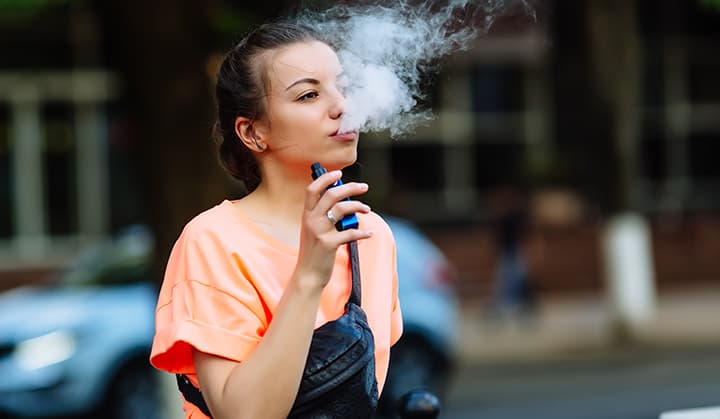Dangerous vaping epidemic: 5 things parents need to know

What once was thought to be a harmless habit has now turned into a national crisis. Hundreds of people have been recently diagnosed with acute lung injury after vaping. Six people across the U.S. have died. Because of this crisis, health officials are now urging people to stop vaping immediately.
What is vaping?
Vaping stimulates smoking through the act of inhaling and exhaling vapors produced by an e-cigarette or another handheld battery-powered vape pen. Some consider it to be a safer alternative to smoking cigarettes, but it’s a dangerous misconception. Cartridges used in vaping devices, eJuice or vape juice pods, are filled with liquid that usually contains chemicals, nicotine and often flavors. Vaping also is referred to as Juuling, since Juul is currently the biggest money-maker in the industry.
What you need to know
The latest statistics show that 1 out of 5 young adults is vaping. Even if your child is not vaping, someone in your life might be. All the news recently about vaping can be overwhelming, so here is a quick list of the top things you need to know.
- Vaping is not inhaling water vapor. Most kids, and some adults, argue vaping is safe because you are “just inhaling water vapor.” But in reality, vaping is heating and inhaling a mixture of chemicals. If you look up the ingredients in eJuice, you will find it includes a chemical also found in antifreeze. So, while vaping is not linked to the same health consequences as traditional smoking, it is far from safe.
What we’re seeing with vaping is that people are getting an exaggerated response to the irritant in their lungs and are having an episode like a severe asthma attack. In some cases, kids are landing in the ICU with acute lung injury, which is when your lungs stop working because they are overwhelmed, trying to fight off an irritant in the airways. This may require some people to need a breathing tube and a breathing machine. Unfortunately, we are seeing an increased number of vaping-related deaths surfacing across the country. - Vaping companies have targeted teens. With their design (resembling a USB drive), brightly colored packaging and myriad of flavors, the industry is directly targeting teens. The flavored eJuice pods, in Juul in particular, have benzoic acid, which allows for a “smoother hit,” ensuring users aren’t subjected to the throat burn associated with tobacco. The number of flavors is unbelievable, everything from candy corn to appletini to a custom build-your-own options. The options mean almost everyone can find a flavor that interests him or her. It has been noted, though, that certain flavors, specifically cinnamon and vanilla, have been associated more often with severe lung reactions.
Adding to the appeal is that vaping is more cost-effective than traditional smoking. With vaping, there is an initial investment of the battery-powered vape pen, but then the flavored e-juice pods are four for $15.99 (which is the equivalent of four packs of cigarettes). In Kansas and Missouri, on average, you will pay $6 for a pack of cigarettes. Someone with a pack-a-day smoking habit would see a significant savings over time by switching to vaping. - Vaping is addictive. Many people associate vaping with being a good way to quit smoking. We all know the negative health aspects of cigarette smoking, so vaping has been promoted as the safer alternative. But is it really safer or is it that we just know less about it? And if you switch from cigarettes to vaping, did you really quit, or did you just change your device for nicotine delivery? It would be like an alcoholic quitting drinking by switching from hard liquor to beer. One pod of eJuice has as much nicotine as 20 cigarettes, so you are still exposing yourself to the same levels of nicotine which is very addictive.
Nicotine in teenage brains has been shown to be associated with poor memory recall and a shorter attention span. Because the teenage brain is still developing, these side effects are even more concerning for this age group. We also know through many studies that once teens start vaping, they are three times more likely to start smoking. - Vaping may have second-hand exposure ramifications. Again, many people think vaping is safer and doesn’t affect those around the person vaping, but that is not true. While different from the known effects of second-hand smoke from cigarettes, vaping is still filling the air with a chemical mist. The same lung reaction we are seeing in people who vape also could potentially be triggered for those who are breathing in the chemicals around the vapor.
- We don’t know the long-term effects of vaping. We know we are seeing more acute lung injuries from vaping, but we still don’t know what the lasting effects from these injuries will be. There may be significant scarring of the lungs which may affect people for the rest of their lives, especially if the initial reaction was severe. While we understand the long-term negative effects of cigarettes, we are just beginning to learn about the effects of vaping.
If someone in your life is vaping and wants to stop, you must treat this addiction like any other and get help. Numerous resources are available, including hotlines, therapy and online groups. For teens there is a great online resource, Students Against Nicotine. This group has been featured on Good Morning America and other national platforms after their video, Juulers against Juul, went viral.

